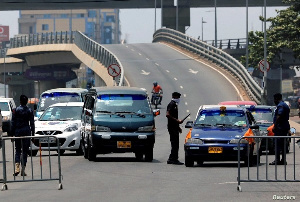 A scene during the partial lockdown of Accra [Credit: Reuters]
A scene during the partial lockdown of Accra [Credit: Reuters]
Mobile phone data provided by Vodafone Ghana has offered an insight into the huge impact that the outbreak of COVID-19, the disease caused by the novel Coronavirus and the subsequent policy measures have had on the movement of people in Ghana with aggregated and anonymized location data showing that people have cut their travels and movements by as much as 40% even after the lockdown measures were eased.
The Ghana Statistical Service (GSS) which helped analyzed the mobile phone tracking data provided by Vodafone Ghana in collaboration with Flowminder Foundation shows that despite the lifting of the lockdown and easing of restrictions, Ghanaians are yet to come to terms with moving about and traveling like they did prior to March 16, considered as the baseline period for the assessment when the announcement of initial restrictions such as the ban on public gathering and closure of schools were made.
The anonymised data, meaning individuals could not be identified, compared the movement of people over four periods: before the initial restrictions, after announcement of the lockdown, during lockdown and after lockdown was lifted.
From the data, analysis of the mobility patterns of people in the Greater Accra Region, which is now the epicenter of the COVID-19 outbreak in Ghana, for instance indicates that although the movement of people especially between two districts during the lockdown period and after has shown an increase, that movement is still 40% less than they did before the initial restrictions came into effect on March 16, and has remained consistently at this level for the entire period since the lockdown measures were lifted.
Meanwhile in the Ashanti Region, the second region to be hard hit by the COVID-19 infections, the movement of people between two regions at least, is 30% below what they used to do before the initial restrictions.
Interestingly, while Greater Accra and Greater Kumasi were the only two out of the 16 regions in the country to be placed under lockdown, the phone data shows there was a rippling effect on the movement of people in other regions as they have also now cut their movements and travels between two districts compared to the baseline period.
Commenting on the report of the mobility pattern of people in the COVID-19 pandemic era, the Government Statistician, Professor Samuel Annim, observed that the findings from the report shows the effectiveness of the government’s communication strategy and the policy measures in containing the spread of the virus.
“The surveillance mechanisms implemented within the Greater Accra and Kumasi were effective, resulting in a dramatic decline in mobility between districts. While the partial lockdown was not imposed on most parts of the country, reduced intra-
regional mobility was observed, generally, across the county, which could be attributed to the population’s understanding of how infections could be controlled. The approach employed in communicating the lockdown and reasons for it should be sustained in getting many more Ghanaians to adhere to the restrictions,” he noted.
The willingness of Vodafone Ghana to create movement maps of anonymised data could prove invaluable in evaluating and shaping the government’s response to the spread of the virus.
Vodafone has already helped various governments around the world in using location data to map out the movements of people including those in Italy and New Zealand.
In Ghana, Vodafone is the second biggest mobile phone network provider in Ghana controlling 21% of the total 41 million voice subscription market as at the end of January this year. As such the phone data provided by Vodafone Ghana may not give a true picture of the actual movement of people. Nonetheless, the data give policymakers an indication of the impact and effectiveness of the policy measures announced by government as part of efforts to tackle COVID-19 in Ghana.
Since Ghana first confirmed the outbreak of COVID-19 in the country on March 12 with two cases, the government has rolled out a raft of measures to contain the spread of the novel Coronavirus. The first major response of the government to the outbreak was made on March 16 when schools were closed and public gatherings were banned nationwide.
Subsequently, the government announced on March 27 that it had placed Greater Accra and Kumasi under lockdown. However, on April 20, the lockdown measures were lifted, a decision the President, Nana Addo Dankwa Akufo Addo explained was influenced by science and data and greater understanding of how the novel Coronavirus behaved in Ghana.
As at press time on Tuesday, Ghana had reported about 5,918 confirmed cases with 1,754 recoveries and 31 deaths.
To help reduce community spread of the virus, the government is yet to give in to growing pressure especially from religious groups to lift the ban on public gatherings and schools closure which is still in force until at least May 31 this year. Ghana’s borders also remain closed until the end of May.
Additionally, Ghanaians are constantly urged to wash their hands thoroughly with soaps under running water, use hand sanitiser sand practice social distancing and stay home if they don’t need to go out.
The Vodafone data shows that at least the stay home campaign is being adhered to.
- Expanding Africa’s vaccine production capacity key – Noguchi Director
- Dengue fever epidemic declared in Burkina Faso
- Frontiers earned over $87m while government got under $7m from COVID testing at KIA – Report
- I donated PPE worth over $1 million during COVID-19 pandemic – Ken Agyapong
- Ablakwa releases ‘inaccessible details’ of contract awarded to Frontiers for COVID test at the airport
- Read all related articles
